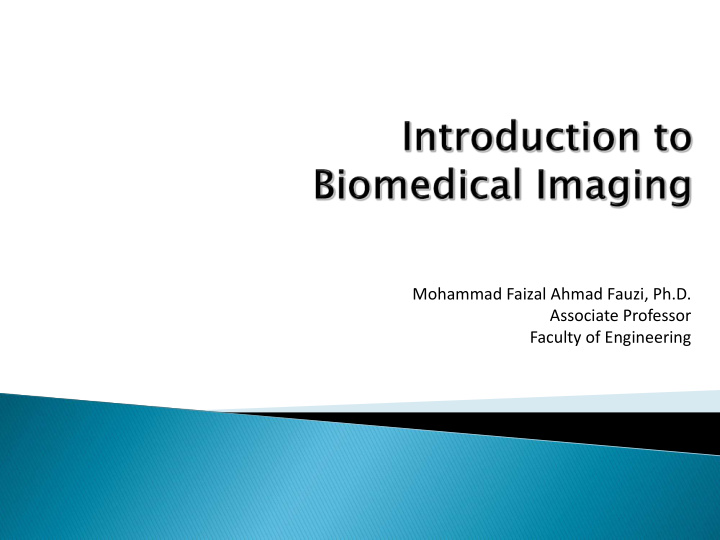



Mohammad Faizal Ahmad Fauzi, Ph.D. Associate Professor Faculty of Engineering
Image ◦ How to represent ◦ How to generate Imaging modalities ◦ How to integrate ◦ How to manage Image Analysis ◦ Radiology ◦ Pathology ◦ Big picture
Imaging Informatics ◦ Subfield of Biomedical Informatics Deals with ◦ Image generation ◦ Image manipulation ◦ Image management ◦ Image integration
Image generation: ◦ Generating images, converting them to digital Image manipulation: ◦ Pre- and post-processing to enhance, visualize, or analyze images Image management: ◦ storing, transmitting, displaying, retrieving and organizing Image integration: ◦ Combine images with other information needed for interpretation, management and other tasks
Images ◦ 2D ◦ 3D ◦ 4D Diagnostic Imaging Modalities ◦ Anatomical: X-ray, fluoroscopy, CT, MRI, US ◦ Functional: PET, SPECT, fMRI Display and Organization Systems
Two dimensional array of numbers
Pixel resolution
Spatial resolution: How well the modality can distinguish points that are close to each other
Distance Pixel connectivity
Eucledian
• Anatomical • Projection radiography (X-ray) • Fluorography • Computed Tomography • Magnetic Resonance Imaging • Ultrasound • Functional • Nuclear Medicine and Positron Emission Tomography
Source: X-ray Detector X-ray attenuation: Density of tissues
Source: Continuous low-power X-ray beam Detector: X-ray image intensifier Continuous acquisition of a sequence of X- ray images over time
Source: Collimated X- ray beam Detector: Solid state scintillators Images: Computer processing of digital readings of detectors Absorption values are expressed in Hounsfield Units
Hounsfield Units • 1000: Bone • -1000: Air • 0: Water
Source: High Intensity magnetic field and radio frequency pulses (on/off) Detector: Phased array receiver RF excitations of the protons results in absorption and subsequent release of energy -> magnetic characteristics of the tissue Pictures of organs, bone, soft tissue Computer generated images
Non- Excellent iodizing soft-tissue contrast detail
Source: High frequency sound waves Detector: Source tranducer also acts as a receiver Images: Sound waves are affected by the different types of tissues encountered and reflected back
Source: X- ray or γ -ray emitting radio-isotopes are injected, inhaled or ingested Detector: Gamma camera – measures the radioactive decay of the active agent Image: Functional information
Core function: storage, distribution and display of medical images Further strengthened by a hospital’s other IT infrastructure Hospital Information System (HIS) Electronic Medical Records System (EMR) Radiology Information System (RIS)
Uses: ◦ Hard copy replacement ◦ Remote access – teleradiology ◦ Integration with other electronic systems ◦ Radiology workflow management
Digital Imaging and Communication in Medicine Standard format for PACS files and messages ◦ A standard for handling, storing, printing, and transmitting information in medical imaging ◦ File format definition and network communication protocol DICOM files can be exchanged between two entities that are capable of receiving image and patient data in DICOM format.
eFilm OsiriX – open source ImageJ
Recommend
More recommend